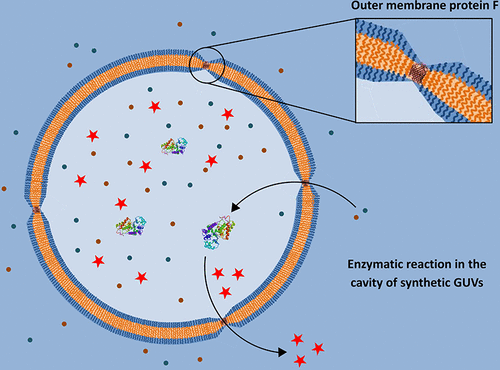当前位置:
X-MOL 学术
›
ACS Synth. Biol.
›
论文详情
Our official English website, www.x-mol.net, welcomes your
feedback! (Note: you will need to create a separate account there.)
Live Follow-Up of Enzymatic Reactions Inside the Cavities of Synthetic Giant Unilamellar Vesicles Equipped with Membrane Proteins Mimicking Cell Architecture
ACS Synthetic Biology ( IF 3.7 ) Pub Date : 2018-08-26 00:00:00 , DOI: 10.1021/acssynbio.8b00104 Martina Garni 1 , Tomaz Einfalt 1 , Roland Goers 1, 2 , Cornelia G. Palivan 1 , Wolfgang Meier 1
ACS Synthetic Biology ( IF 3.7 ) Pub Date : 2018-08-26 00:00:00 , DOI: 10.1021/acssynbio.8b00104 Martina Garni 1 , Tomaz Einfalt 1 , Roland Goers 1, 2 , Cornelia G. Palivan 1 , Wolfgang Meier 1
Affiliation

|
Compartmentalization of functional biological units, cells, and organelles serves as an inspiration for the development of biomimetic materials with unprecedented properties and applications in biosensing and medicine. Because of the complexity of cells, the design of ideal functional materials remains a challenge. An elegant strategy to obtain cell-like compartments as novel materials with biofunctionality is the combination of synthetic micrometer-sized giant unilamellar vesicles (GUVs) with biomolecules because it enables studying the behavior of biomolecules and processes within confined cavities. Here we introduce a functional cell-mimetic compartment formed by insertion of the model biopore bacterial membrane protein OmpF in thick synthetic membranes of an artificial GUV compartment that encloses—as a model—the oxidative enzyme horseradish peroxidase. In this manner, a simple and robust cell mimic is designed: the biopore serves as a gate that allows substrates to enter cavities of the GUVs, where they are converted into products by the encapsulated enzyme and then released in the environments of GUVs. Our bioequipped GUVs facilitate the control of specific catalytic reactions in confined microscale spaces mimicking cell size and architecture and thus provide a straightforward approach serving to obtain deeper insights into biological processes inside cells in real time.
中文翻译:

配有膜蛋白模拟细胞结构的合成巨型单层囊泡腔内酶促反应的实时跟进
功能性生物单位,细胞和细胞器的区室化为仿生材料的开发提供了灵感,这些材料具有空前的特性,并在生物传感和医学中得到了应用。由于电池的复杂性,理想的功能材料的设计仍然是一个挑战。一种获得具有生物功能的新型材料的细胞状隔室的绝妙策略是将合成的微米级巨型单层囊泡(GUV)与生物分子相结合,因为它可以研究密闭腔体内生物分子的行为和过程。在这里,我们介绍了一种通过模拟生物孔细菌膜蛋白OmpF插入人造GUV隔室的厚合成膜中而形成的功能细胞模拟隔室,该膜围绕着氧化酶辣根过氧化物酶(作为模型)。以这种方式,设计了一种简单而强大的细胞模拟物:生物孔用作门,允许底物进入GUV的腔体,在那里它们被封装的酶转化为产物,然后在GUV的环境中释放。我们配备生物功能的GUV有助于在密闭的微尺度空间内控制特定的催化反应,从而模仿细胞的大小和结构,因此提供了一种直接的方法,可以实时深入地了解细胞内的生物过程。生物孔用作门,允许底物进入GUV的腔中,在腔中它们被封装的酶转化为产物,然后在GUV的环境中释放出来。我们配备生物功能的GUV有助于在模仿细胞大小和结构的狭窄微空间内控制特定的催化反应,因此提供了一种直接的方法,可用于实时深入了解细胞内的生物过程。生物孔用作门,允许底物进入GUV的腔中,在腔中它们被封装的酶转化为产物,然后在GUV的环境中释放出来。我们配备生物功能的GUV有助于在模仿细胞大小和结构的狭窄微空间内控制特定的催化反应,因此提供了一种直接的方法,可用于实时深入了解细胞内的生物过程。
更新日期:2018-08-26
中文翻译:

配有膜蛋白模拟细胞结构的合成巨型单层囊泡腔内酶促反应的实时跟进
功能性生物单位,细胞和细胞器的区室化为仿生材料的开发提供了灵感,这些材料具有空前的特性,并在生物传感和医学中得到了应用。由于电池的复杂性,理想的功能材料的设计仍然是一个挑战。一种获得具有生物功能的新型材料的细胞状隔室的绝妙策略是将合成的微米级巨型单层囊泡(GUV)与生物分子相结合,因为它可以研究密闭腔体内生物分子的行为和过程。在这里,我们介绍了一种通过模拟生物孔细菌膜蛋白OmpF插入人造GUV隔室的厚合成膜中而形成的功能细胞模拟隔室,该膜围绕着氧化酶辣根过氧化物酶(作为模型)。以这种方式,设计了一种简单而强大的细胞模拟物:生物孔用作门,允许底物进入GUV的腔体,在那里它们被封装的酶转化为产物,然后在GUV的环境中释放。我们配备生物功能的GUV有助于在密闭的微尺度空间内控制特定的催化反应,从而模仿细胞的大小和结构,因此提供了一种直接的方法,可以实时深入地了解细胞内的生物过程。生物孔用作门,允许底物进入GUV的腔中,在腔中它们被封装的酶转化为产物,然后在GUV的环境中释放出来。我们配备生物功能的GUV有助于在模仿细胞大小和结构的狭窄微空间内控制特定的催化反应,因此提供了一种直接的方法,可用于实时深入了解细胞内的生物过程。生物孔用作门,允许底物进入GUV的腔中,在腔中它们被封装的酶转化为产物,然后在GUV的环境中释放出来。我们配备生物功能的GUV有助于在模仿细胞大小和结构的狭窄微空间内控制特定的催化反应,因此提供了一种直接的方法,可用于实时深入了解细胞内的生物过程。











































 京公网安备 11010802027423号
京公网安备 11010802027423号